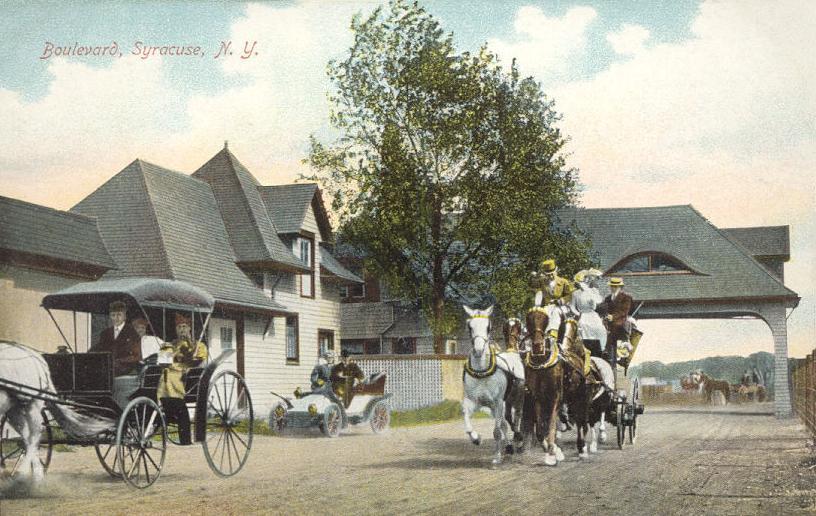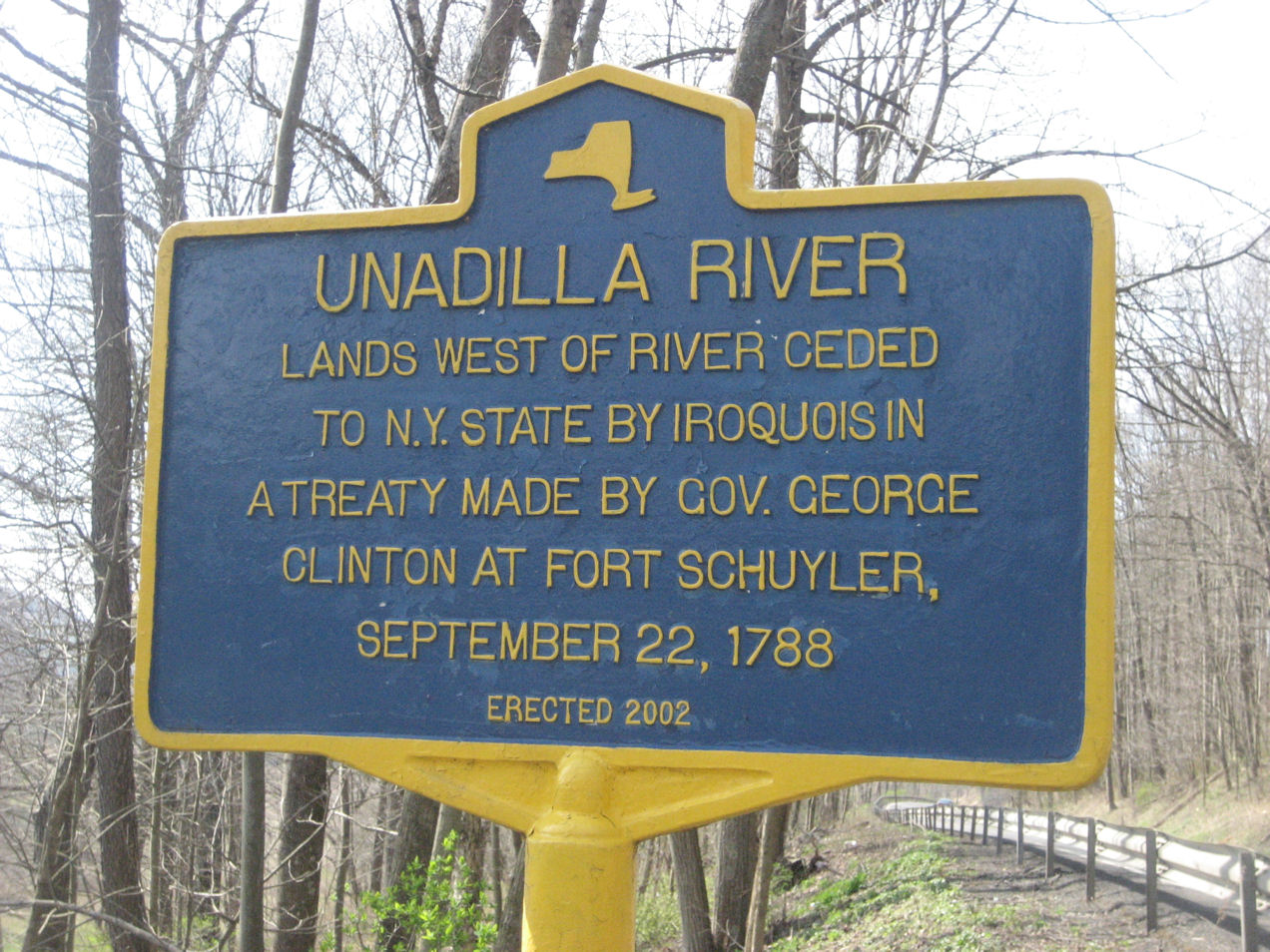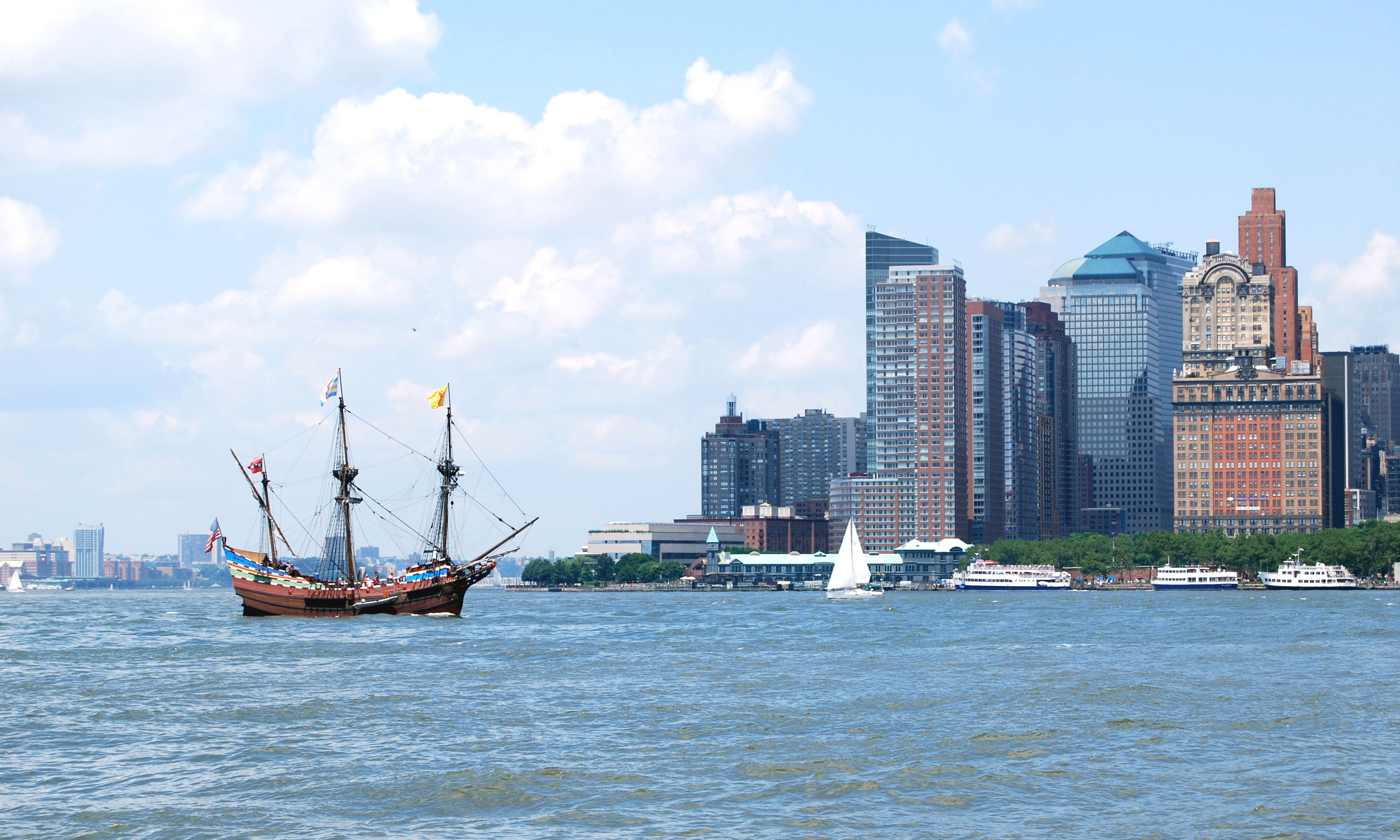|
Seneca Turnpike
The Seneca Road Company was formed to improve the main road running west from Utica, New York, the Genesee Road, from Utica to Canandaigua and operate it as a toll road or turnpike. The road was originally laid out in 1794 from Baggs Square in downtown Utica (then Old Fort Schuyler) at the ford of the Mohawk River and followed the Indian trail past Syracuse to Canandaigua. Some accounts say it went to Geneva and Avon originally. There was no City of Syracuse then. The road became known as the Seneca Turnpike, which was long and, at the time, the longest toll road in the state. On April 1, 1800, the privately held Seneca Road Company received a state charter with a capitalization of $110,000. This was a stock company with prominent local investors including Jedediah Sanger, Benjamin Walker, John Kirkland, and Wilhelmus Mynderss. The company received a land grant of a right of way, but the roadway was . The firm was required to clear a road wide of all trees. Completed to ... [...More Info...] [...Related Items...] OR: [Wikipedia] [Google] [Baidu] |
Utica, New York
Utica () is a Administrative divisions of New York, city in the Mohawk Valley and the county seat of Oneida County, New York, United States. The List of cities in New York, tenth-most-populous city in New York State, its population was 65,283 in the 2020 United States Census, 2020 U.S. Census. Located on the Mohawk River at the foot of the Adirondack Mountains, it is approximately west-northwest of Albany, New York, Albany, east of Syracuse, New York, Syracuse and northwest of New York City. Utica and the nearby city of Rome, New York, Rome anchor the Utica–Rome Metropolitan Statistical Area comprising all of Oneida and Herkimer County, New York, Herkimer Counties. Formerly a river settlement inhabited by the Mohawk people, Mohawk Nation of the Iroquois Confederacy, Utica attracted European-American settlers from New England during and after the American Revolution. In the 19th century, immigrants strengthened its position as a layover city between Albany and Syracuse ... [...More Info...] [...Related Items...] OR: [Wikipedia] [Google] [Baidu] |
Canandaigua
Canandaigua (; ''Utaʼnaráhkhwaʼ'' in Tuscarora) is a city in Ontario County, New York, United States. Its population was 10,545 at the 2010 census. It is the county seat of Ontario County; some administrative offices are at the county complex in the adjacent town of Hopewell.Google Maps (3019 County Complex Drive, Canandaigua, New York) Retrieved Jan. 14, 2015.Ontario County, New York Retrieved Jan. 14, 2015. The name Canandaigua is derived from the |
Toll Road
A toll road, also known as a turnpike or tollway, is a public or private road (almost always a controlled-access highway in the present day) for which a fee (or ''toll'') is assessed for passage. It is a form of road pricing typically implemented to help recoup the costs of road construction and maintenance. Toll roads have existed in some form since antiquity, with tolls levied on passing travelers on foot, wagon, or horseback; a practice that continued with the automobile, and many modern tollways charge fees for motor vehicles exclusively. The amount of the toll usually varies by vehicle type, weight, or number of axles, with freight trucks often charged higher rates than cars. Tolls are often collected at toll plazas, toll booths, toll houses, toll stations, toll bars, toll barriers, or toll gates. Some toll collection points are automatic, and the user deposits money in a machine which opens the gate once the correct toll has been paid. To cut costs and minimise time delay, ... [...More Info...] [...Related Items...] OR: [Wikipedia] [Google] [Baidu] |
Mohawk River
The Mohawk River is a U.S. Geological Survey. National Hydrography Dataset high-resolution flowline dataThe National Map accessed October 3, 2011 river in the U.S. state of New York. It is the largest tributary of the Hudson River. The Mohawk flows into the Hudson in Cohoes, New York, a few miles north of the city of Albany.Mohawk River , The Columbia Gazetteer of North America The river is named for the of the Iroquois Confederacy. It is a major waterway in north-central New York. The largest tributary, the Schoharie Creek, accounts fo ... [...More Info...] [...Related Items...] OR: [Wikipedia] [Google] [Baidu] |
Syracuse, New York
Syracuse ( ) is a City (New York), city in and the county seat of Onondaga County, New York, Onondaga County, New York, United States. It is the fifth-most populous city in the state of New York following New York City, Buffalo, New York, Buffalo, Yonkers, New York, Yonkers, and Rochester, New York, Rochester. At the United States Census 2020, 2020 census, the city's population was 148,620 and its Syracuse metropolitan area, metropolitan area had a population of 662,057. It is the economic and educational hub of Central New York, a region with over one million inhabitants. Syracuse is also well-provided with convention sites, with a Oncenter, downtown convention complex. Syracuse was named after the classical Greek city Syracuse, Sicily, Syracuse (''Siracusa'' in Italian), a city on the eastern coast of the Italian island of Sicily. Historically, the city has functioned as a major Crossroads (culture), crossroads over the last two centuries, first between the Erie Canal and its ... [...More Info...] [...Related Items...] OR: [Wikipedia] [Google] [Baidu] |
Geneva, New York
Geneva is a City (New York), city in Ontario County, New York, Ontario and Seneca County, New York, Seneca counties in the U.S. state of New York (state), New York. It is at the northern end of Seneca Lake (New York), Seneca Lake; all land portions of the city are within Ontario County; the water portions are in Seneca County. The population was 13,261 at the 2010 census. The city is supposedly named after the city and canton of Geneva in Switzerland. The main settlement of the Seneca was spelled Zoneshio by early white settlers, and was described as being two miles north of Seneca Lake. The city borders, and was once part of, the town of Geneva (town), New York, Geneva. The city identifies as the "Lake Trout Capital of the World." History The area was long occupied by the Seneca tribe, which had established a major village of ''Kanadaseaga'' here by 1687. The British helped fortify the village against the French of Canada during the Seven Years' War (locally known as the Fr ... [...More Info...] [...Related Items...] OR: [Wikipedia] [Google] [Baidu] |
Avon, New York
Avon () is a town in Livingston County, New York, United States. It is south of Rochester. The town population was 7,146 at the 2010 census. The town was named after the River Avon in England. The village of Avon is in the northwest part of the town. History The area around and including what would become Avon village was inhabited for millennia by Paleo-Indians and later by the Seneca people, the western-most tribe of the Iroquois Confederacy. After the Iroquois title to the land was extinguished in 1788 with the Phelps and Gorham Purchase, white and Black settlement of the area began. In 1789, Dr. Timothy Hosmer, Maj. Isaiah Thompson, William Wadsworth, and others from Hartford, Connecticut, purchased a tract east of the Genesee River and named it "Hartford" after their homeland. The town was organized in 1797. The town's name was changed to "Avon" in 1808 to avoid confusion with another Hartford in Washington County, New York. In 1818, part of the town was removed to fo ... [...More Info...] [...Related Items...] OR: [Wikipedia] [Google] [Baidu] |
Jedediah Sanger
Jedediah Sanger (February 28, 1751 – June 6, 1829) was the founder of the town of New Hartford, New York, United States. He was a native of Sherborn, Massachusetts, and the ninth child of Richard and Deborah Sanger, a prominent colonial New England family. During the American Revolutionary War, Revolutionary War he attained the rank of First lieutenant, 1st Lieutenant having fought in the Battles of Lexington and Concord, the Battle of Bunker Hill, the Siege of Boston (1776), and during the New York Campaign. After the war, he settled in Jaffrey, New Hampshire, where he began farming, trading, and running a tavern. He was involved in several civic activities and was appointed Lieutenant colonel, Lt. Colonel of the New Hampshire militia. After a fire destroyed his property, leaving him bankrupt, he started over in the frontier of central New York, New York. Sanger settled in what was then called Whitestown, New York, Whitestown. He became a land agent or speculator, buying lar ... [...More Info...] [...Related Items...] OR: [Wikipedia] [Google] [Baidu] |
Buffalo, New York
Buffalo is the second-largest city in the U.S. state of New York (behind only New York City) and the seat of Erie County. It is at the eastern end of Lake Erie, at the head of the Niagara River, and is across the Canadian border from Southern Ontario. With a population of 278,349 according to the 2020 census, Buffalo is the 78th-largest city in the United States. The city and nearby Niagara Falls together make up the two-county Buffalo–Niagara Falls Metropolitan Statistical Area (MSA), which had an estimated population of 1.1 million in 2020, making it the 49th largest MSA in the United States. Buffalo is in Western New York, which is the largest population and economic center between Boston and Cleveland. Before the 17th century, the region was inhabited by nomadic Paleo-Indians who were succeeded by the Neutral, Erie, and Iroquois nations. In the early 17th century, the French began to explore the region. In the 18th century, Iroquois land surrounding Buffalo Creek ... [...More Info...] [...Related Items...] OR: [Wikipedia] [Google] [Baidu] |
New York State Route 5
New York State Route 5 (NY 5) is a state highway that extends for across the state of New York in the United States. It begins at the Pennsylvania state line in the Chautauqua County town of Ripley and passes through Buffalo, Syracuse, Utica, Schenectady, and several other smaller cities and communities on its way to downtown Albany in Albany County, where it terminates at U.S. Route 9 (US 9), here routed along the service roads for Interstate 787 (I-787). Prior to the construction of the New York State Thruway, it was one of two main east–west highways traversing upstate New York, the other being US 20. West of New York, the road continues as Pennsylvania Route 5 (PA 5) to Erie. NY 5 overlaps with US 20 twice along its routing. The second, a overlap through western and central New York, is the second-longest concurrency in the state, stretching from Avon in Livingston County east to the city of Auburn in Cayu ... [...More Info...] [...Related Items...] OR: [Wikipedia] [Google] [Baidu] |
History Of New York (state)
The history of New York begins around 10,000 B.C. when the first people arrived. By 1100 A.D. two main cultures had become dominant as the Iroquoian and Algonquian developed. European discovery of New York was led by the Italian Giovanni da Verrazzano in 1524 followed by the first land claim in 1609 by the Dutch. As part of New Netherland, the colony was important in the fur trade and eventually became an agricultural resource thanks to the patroon system. In 1626 the Dutch thought they had bought the island of Manhattan from Native Americans. In 1664, England renamed the colony New York, after the Duke of York and Albany, brother of King Charles II. New York City gained prominence in the 18th century as a major trading port in the Thirteen Colonies. New York played a pivotal role during the American Revolution and subsequent war. The Stamp Act Congress in 1765 brought together representatives from across the Thirteen Colonies to form a unified response to British policie ... [...More Info...] [...Related Items...] OR: [Wikipedia] [Google] [Baidu] |
Turnpikes In New York (state)
Turnpike often refers to: * A type of gate, another word for a turnstile * In the United States, a toll road Turnpike may also refer to: Roads United Kingdom * A turnpike road, a principal road maintained by a turnpike trust, a body with powers to collect road tolls in Britain from the 17th but especially during the 18th and 19th centuries * Turnpike Lane, Haringey, a street in Haringey, North London, England United States * Connecticut Turnpike, a former toll road in Connecticut, United States * Delaware Turnpike, a toll road in Delaware, United States * Florida's Turnpike, a toll road in Florida, United States * Homestead Extension of Florida's Turnpike, a toll road in Florida, United States (part of Florida's Turnpike) * Indiana Toll Road, a toll road in Indiana, United States (often called "the Indiana Turnpike") * Kansas Turnpike, a toll road in Kansas, United States * Kentucky Turnpike, a former toll road in Kentucky, United States * Maine Turnpike, a toll road in Maine, U ... [...More Info...] [...Related Items...] OR: [Wikipedia] [Google] [Baidu] |







